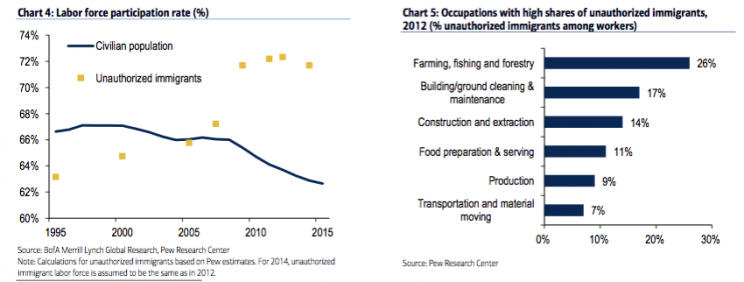The vast majority of undocumented immigrants in the US are here working: BAML
With Donald Trump as the presumptive Republican nominee for president, the topic of immigration will likely emerge as a major topic of debate during the general election.
Trump’s opponent, Hillary Clinton, has framed the need for immigration reform as a family issue and an “economic issue” while calling for a “pathway to citizenship” for undocumented immigrants.
Indeed, many undocumented immigrants in the US already contribute a great deal to the country’s economy, according to a new report from Bank of America Merrill Lynch (BAML). That report noted that in 2014 unauthorized immigrants had a labor force participation rate of 70% compared to 62.9% for the overall population.
BAML also cited research that refutes the notion that America’s roughly 11 million unauthorized immigrants might be “taking” jobs from US citizens.
“[A] study from the National Bureau of Economic Research shows that immigrants are imperfect substitutes for native US workers due to different occupation choices and skills and immigration has a positive effect on the average wage of US-born workers overall,” BAML noted.
Of course, new policies on immigration could change the economic situation for those who came to the US without authorization. The BAML report looks at two possible scenarios that could change the labor participation rate for undocumented immigrants — one of which Trump has proposed and the other of which Clinton has called for in the past.
The first scenario — which Trump has championed — would expand a program known as e-verify that lets businesses determine the eligibility of employees to work in US. If that program were mandated across the US for new hires, as Trump wants it to be, the labor force would shrink by 3.8 percentage points over the next 15 years, according to BAML. That would slice .1 percentage point from real GDP growth per year, and the federal debt-to-GDP ratio would be 1.5 percentage points higher at the end of a 15-year period.
BAML’s second scenario would benefit the economy and would involve increasing the number of H-1B visas (which let US companies hire foreign workers) and employment-based green cards issued. (Hillary Clinton spoke out back in 2007 in favor of increasing H-1B visas.) Meanwhile, this proposal would eliminate both green cards for the siblings of US citizens and diversity visas.
This move would boost the overall labor force by .7 percentage points over a 15-year period; increase real GDP by .7 percentage points; and lower the debt to GDP ratio by 1.1 percentage points.
Regardless of what form immigration reform takes, there is a growing call for it. That’s partly because the Supreme Court recently blocked President Barack Obama’s plan to help 4 million unauthorized immigrants live and work in the US without fear of deportation.
A 2009 report from the Council on Foreign Relations still seems relevant today, noting: “The continued failure to devise and implement a sound and sustainable immigration policy threatens to weaken America’s economy, to jeopardize its diplomacy, and to imperil its national security.”
Read more:
How the Supreme Court is hurting the economy by killing immigration reform
Undocumented immigrants pay billions in taxes: study
The profound business implications of that viral Chewbacca mask




